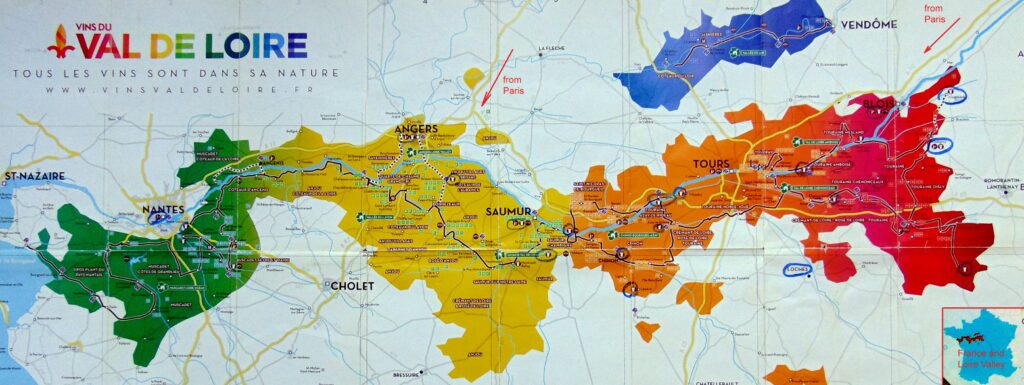Honore de Balzac Museum and Sache Castle (Château de Saché).
Built on the foundations of a 12th-century fortress, of which a cylindrical tower and part of a dry moat remain, the Château de Sachet is a fine French Renaissance mansion.
Enlarged by a wing in the 17th century and then by a second in the 18th century, all of its interiors were furnished in the 19th century by its owner, Jean de Margonne, in keeping with the style of the time. Honore de Balzac stayed there several times from 1825 to 1848. He found there his inspiration for several of his great novels and his comfort in writing them: first Le Lys dans la Vallée, but also among other novels La Comédie Humaine. Goriot’s father, César Birroto, Louis Lambert, among others. Balzac, from his bedroom window, sees his “lonely valley,” as he calls it. He revisited the prime of his youth and wrote Le Lys dans la Vallée, his most beautiful love story, in memory of the love of his youth, who was Laura de Bernie.
In June 1848, Balzac returned to Sasha, wrote to Madame Hanske and told him about his stay in Sasha.
The Metadier family took over the castle in 1922. They later turned it into a museum dedicated to Balzac. Collected hundreds of items. In 1951, the museum was opened by the president of the French Academy, Georges Duhamel. Mr. Paul Metadier becomes his curator. In 1958, he donated the castle to the General Council of Indre and Loire, which became its owner.
Museum collections.
Precious printed products Fund. The printed editions of the collection of the Balzac Museum (about 1000 copies) mainly consist of a unique collection donated by Bernard-Paul Metadier and the Samueli collection. Thanks to various donations, Bernard-Paul Metadier enriched the collection of engravings of the Balzac Museum with his interests, objects and hobbies. Thus, some topics were prioritized: Balzac’s Touraine, Balzac’s Paris, Balzac and science, Balzac and the press. The Samueli Foundation was acquired by the General Council of Indre-et-Loire in 2002 with financial support from the DRAC and the Center region. It consists of approximately six hundred bound volumes. This is an exceptional collection built over several decades by Jean-Jacques Samueli, a passionate collector. This fund includes, in particular, all of his early works, which he published under various pseudonyms. The first then completely unknown works of the author have become practically inaccessible to trace today. The fund also contains almost all the first editions of Balzac’s novels and short stories, very beautiful illustrated ones, collections and illegal editions of Belgium and Holland.
Manuscripts. Among its collections of manuscripts (correspondence of Balzac and his contemporaries), the Balzac Museum keeps three collections of handwritten corrections of the novel “Le Lys dans la vallée”, which make up the second, third and fourth folder of all documents, which allow us to trace the origin of this novel (manuscript, cabinets and other folders are kept at the Institut de France in the Spoelberch collection in Lowenjoules). He also has volumes corrected from China (nine leaves corrected by Balzac’s hand) and an edition by Louis Lambert annotated by Balzac’s hand.
Oil Paintings. Since 2013, the Musée Balzac has exhibited a portrait of Mrs. Hansky’s daughter and her son-in-law Jean Gigot, as well as a portrait of Mr. Hansky by Giuseppe Bezzuoli. These collections are kept in the Maison de Balzac (Paris).
Sculptures. Balzac was represented by several sculptors, including David d’Angers, Marquet de Vasselot, Auguste Rodin and Alexandre Falguière, whose work is on display at the Balzac Museum. Commissioned by the Society for the Sociology of Women in 1891, Rodin’s work was the subject of numerous preparatory studies, including several plasters and bronzes that trace origins (museum collections and Balzac’s warehouses). In 1892, Auguste Rodin came to stay in the Indre Valley, to the Château de l’Islette, to draw inspiration from the novelist’s home region and begin the first studies of his Balzac.
The Balzac Museum also exhibits a whole series of plasters and terracotta by Pierre Riper, representing the characters of the comedy “Man” and sculptures that evoke Balzac’s personal taste for art (works after Falcone, Michel Ange, Michallon), sources of inspiration for his novels.
Drawings and engravings. In its collection of engravings, the Balzac Museum keeps many caricatures from the first half of the 19th century. This art, especially complementary to the study of manners painted by Balzac, did develop during this period. Note that a writer who is closely associated with the press has often been the target of cartoonists.
Printing equipment. A 19th-century printing shop reconstructed to evoke the printing profession that Balzac practiced from 1826 to 1828. It includes a Stanhope typepress, a mid-19th century lithographic print, a bookbinding machine, an old guillotine, and print breaks.
See also our routes from Paris by a car:
- The Loire Valley private tours, Wine, the Castles, Military museums and WW2 battlefields

